Please Take Note: This is a review of the final game, but it might change slightly based on the success of the Kickstarter campaign. The game is being reviewed on the components and the rules provided with the understanding that “what you see is not what you might get” when the game is published. If you like what you read and want to learn more, we encourage you to visit the game’s web page or visit the Kickstarter campaign. Now that we have all that disclaimer junk out of the way, on with the review!

The Basics:
- For ages 9 and up (publisher suggests 10+)
- For 2 to 5 players
- Approximately 60 minutes to complete
Geek Skills:
- Counting & Math
- Logical & Critical Decision Making
- Reading
- Pattern Matching
- Strategy & Tactics
- Semi-Cooperative Team Play
- Hand/Resource Management
- Worker Placement & Area Control
Learning Curve:
- Child – Easy
- Adult – Easy
Theme & Narrative:
- Join forces to battle the Darkness!
Endorsements:
- Gamer Geek mixed!
- Parent Geek mixed!
- Child Geek mixed!
Overview
Darkness crept into the land unseen. At first there were rumors, stories, and hearsay that would suggest that something wasn’t right on the frontier, but none listened. The great races of the Five Realms were at odds with each other and only looked to their own concerns and borders. When the Darkness appeared on the horizon, the great races set aside their differences and banded together to fight their common enemy. Victory is within reach, but only one race can be the true hero of this war.
Warband: Against the Darkness, designed by Micah Fuller and to be published by Dyskami Publishing Company, will reportedly be comprised of a two-part game board (one side depicting the the Five Realms and the other side depicts the Warband Roster, 24 Enemy cards, 20 Intel cards, 30 Redress cards, 106 wooden Unit cubes (20 of each in the colors black, blue, red, white, and yellow, plus 6 brown mercenary units), 38 wooden Captain meeples (7 of each in the colors black, blue, red, white, and yellow, plus 3 brown mercenary captains), 10 Race boards (Dragonfolk, Dwarves, Elementals, Elves, Giants, Halflings, Minotaurs, Rockmen, Rodentia, and Wolfaen), 5 Action Track boards, 5 Player Aid boards, an unspecified total number of cardboard Gold coins (in the values of 1, 3, and 5), 1 Round tracker token, and 1 pencil and score pad. As this is a review of a prepublished game, we will not comment on the game component quality of the prototype we were provided. I would like to note that the artwork by Robert Altbauer and Joseph Shawcross is simply fantastic.
Preparing for War
To set up the game, first place the game boards in the middle of the playing area. One side will depict the Five Realms where the players are fighting against the ever growing Darkness and the other side depicts each player’s advancements through the Warband Roster. Place the Round tracker token on the round tracking space that lists the number of players in the game.
Second, place 1 “Mercenary” Captain meeple and 2 “Mercenary” Unit cubes (both are brown) on the Light Infantry, Cavalry, and Archery spaces found on the Warband Roster’s bottom most row.
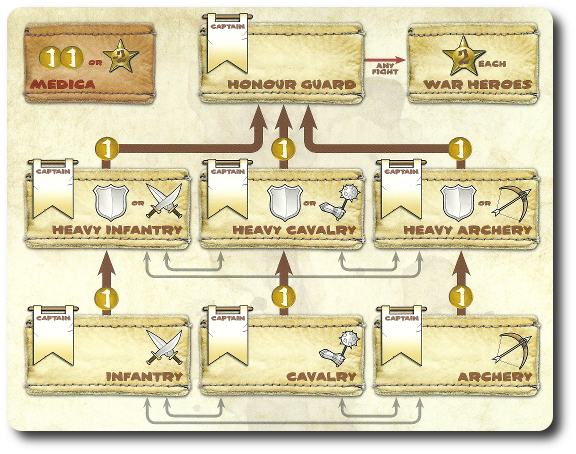
Third, give each player 1 Action Track board, 1 Player Aid board, and 3 Gold. All remaining Gold should be placed to one side of the game playing area. This is the Gold supply for the duration of the game. Note that the Action Track boards are the same regardless of the Race selected.
Fourth, either randomly select or allow each player to choose their Race boards. The Race boards are placed above the player’s Action Track board. Any Race boards not selected are returned to the game box.
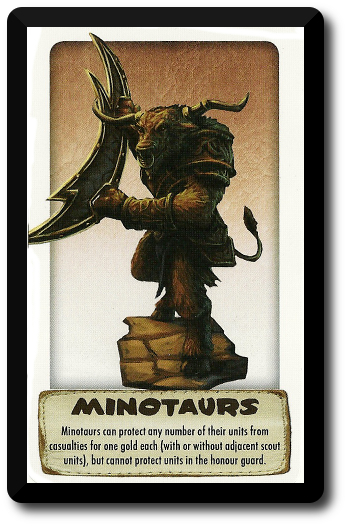
Fifth, give each player the Captain meeples and Unit cubes that match their Action Track color. The meeples are places to the left of the player’s Action Track board and the cubes are placed to the right. Both of these areas are referred to as the “reserve”. At this time, each player should take 12 cubes and place them on their Action Track board to cover up the rank 2, rank 3, and rank 4 columns on their Action Track board (4 cubes per column). The rank 1 “Novice” column should be cube-free.
Sixth, find the 3 starting Enemy cards (these will have a green background) and place them randomly and face-up on each of the left-most battlefield spaces on the Five Realms (the fourth and right-most battlefield, The Branches, will be left blank for the moment). These represent the initial enemy forces invading the Five Realms.
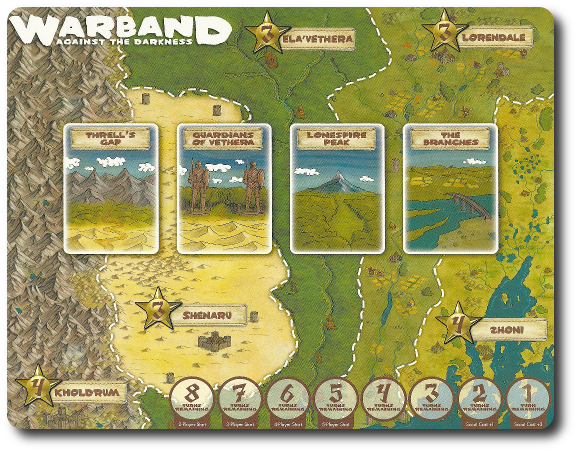
Seventh, organize the Enemy and Intel cards into their own decks and give each deck a good shuffle. Place the decks to one side of the game boards, face-down.
Eighth, determine if the players want to play an easier or more difficult game. If the players want to play an easier game, find the Redress cards with a brown background in their title, removing the other Redress cards from the game. If the players want to play a more difficult game, take 10 Redress cards with the brown background and 10 Redress cards with the white background in their titles to create the Redress deck. Again, any remaining Redress cards are removed from the game. Give the Redress deck a good shuffle and place it next to the other 2 decks, face-down.
Ninth, determine who the first player is and have them place one Unit cube from their reserve to the Kholdrum region found on the Five Realms map. The second player places 1 Unit cube in the Shenaru region, the third player in the Ela’Vethera region, the fourth player in the Lorendale region, and the fifth player in the Zhoni region.
This completes game set up. Time to go to war.
Waging War
Note: We will only summarize the game play here. For additional details and the complete rules, refer to the rule book.
Warband is played in rounds. The total number of rounds in the game is determined by the number of players. A player’s turn consists of 2 phases. Each phase is further broken down into additional actions. A player’s turn is summarized here.
Note: Each Race in the game has a different and unique ability that are utilized during different phases and actions in the game.
Whenever
As the game progresses, the player will suffer casualties. Casualties are sent to the Medica space on the Warband Roster. At anytime during their turn (before, after, or during any of the 2 phases) without costing an action, the player can retrieve 1 cube at the cost of 2 Gold. The Gold is placed in the Gold supply and the now fully healed Unit cube is placed in the player’s reserve.
Phase 1: Upgrading
The first thing a player can do is upgrade their own army. This is done by removing 1 cube from their Action Track and placing it into their reserve. When removing a cube, it can be from any row, but the cube in the left-most column is always removed first. What cubes the players remove throughout the game is up to them and creates a unique racial army in the process. Note that the players will have, at most, 8 rounds of play and there are 12 cubes covering the player’s Action Track board. This means that the players will have to carefully determine how they want to tailor their own specific race.
The actions are summarized here and explained in more detail in phase 2.
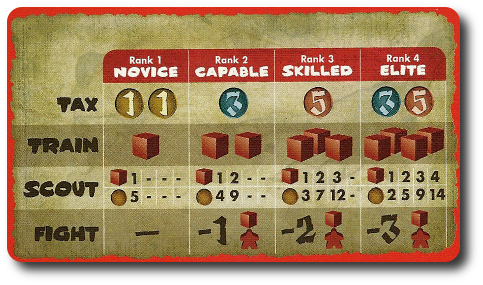
Tax
This action allows the player to collect Gold on their turn. The initial action value is 2 Gold. From there, the player can upgrade it to 3, 5, and 8 Gold.
Train
This action allows the player to move Unit cubes on the Warband Roster. The initial action value is 1 Unit cube. From there, the player can upgrade to 2, 3, and 4 cubes.
Scout
This action allows the player to move Unit cubes to the field and scout. The initial action value is 1 Unit cube at the cost of 5 gold. From there, the player can upgrade to moving 2 cubes, 3, cubes, and 4 cubes at different cost values.
Fight
This action allows the player to engaged the enemy forces. The initial value does not provide any bonuses. From there, the player can upgrade to -1 Unit requirements and Captain wages, -2 Unit requirements and Captain wages, and -3 Unit requirements and Captain wages.
Phase 2: Taking Actions
Now the player gets to take 3 actions. They can take 3 different actions, 2 actions of the same type and 1 different action, or 3 actions of the same type. The player is welcome to mix and match as much as they like as long as they do not exceed the maximum number of actions allowed. Again, players should take note of their Race’s special ability. Each of the actions are summarized here and are influenced by the ranking on the player’s Action Track board.
Tax
The player takes from the Gold supply a number of Gold equal to the value on their highest available Tax rank. If necessary, the player can make change. If there are no more Gold coins to collect, the player should write down their total Gold on a piece of paper (players can always get Gold regardless of the supply). Collected Gold is places in the player’s reserve.
Train
The player takes 1 Unit cube and trains it by moving up or left or right on the Warband Roster. Moving a Unit up through the ranks costs 1 Gold, but moving it sideways does not. Moving a Unit from the player’s reserve to the bottom row costs 1 Gold. Players should always follow the arrows on the Warband Roster when determining training movement except for the War Heroes space which cannot be obtained through training alone. At no time can a Unit be “untrained” by moving them down in the Warband Roster.
Immediately after moving Units, the players should determine who has the captaincy for spaces on the Warband Roster. The player who has the most Unit cubes in the Warband Roster spaces places a Captain meeple in the “Captain” banner space. At the beginning of the game, the Mercenary are captains of the light infantry, archery, and cavalry. Ties do not remove the current captain. Removed Captain meeples are returned to their owner’s reserve.
Scout
Scouts are beneficial for several reasons. First, they help during combat. Second, they help with intel. Third, they help you win the game by providing victory points. Putting Scouts into position costs money, however. When moving a Unit cube from the player’s reserve to the Five Realms, the player can place their cube on any of the regions, but no more than 1 Scout can be placed in each region per action. For example, if the player had the ability to move 3 Scouts for 1 action, they could place 1 Scout in 3 different regions. Not 3 Scouts in the same region. There is no limit to the number of Scouts a region can contain.
As the game progresses, it will become more difficult to place Scouts due to the growing threat by the Darkness.
Fight
To remove the threat of Darkness from the Five Realms, the players must wage war against their enemy. Before a player can select this action, the total number of Units from all the players (plus the Mercenaries) must be equal to or greater than the combined platoon requirements on the face-up Enemy cards. Combat is done by completing the following steps.
Step 1: Check Warband Strength
To determine the Warband strength, look at the large image in the middle of the Enemy card. This indicates the Enemy platoon type (infantry, cavalry, archery, or heavy). There is a number in a star on the Enemy card. This identifies the number of the platoon type shown. The player then determines if the Units from all the players on the Warband Roster can match the Warband strength by making a match 1:1 for all the face-up Enemy cards.
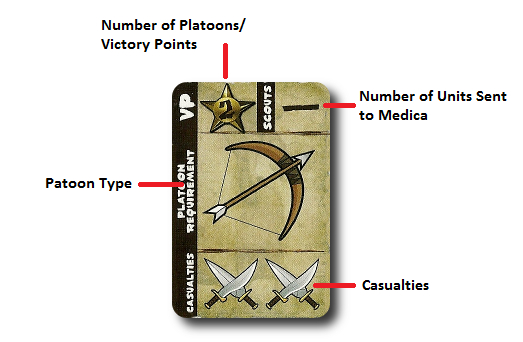
Step 2: Pay Captain’s Wages
The player now pays 1 Gold to each player for every Captain meeple they have on the Warband Roster. The player does not need to pay their own Captains. Payment to Mercenary Captains are placed back in the Gold supply.
Step 3: Defeat Enemy
The player then selects 1 face-up Enemy card and removes it from the Five Realms map, placing it next to their Action track, face-up. Any Gold on that Enemy card is placed in the player’s reserve.
Step 4: Draw Intel Cards
The player now draws the top 2 Intel cards, looks at them, and places the Intel card they DO NOT WANT on the BOTTOM of the Intel deck. The Intel card they kept should remain hidden from their opponents. Note that Intel cards are matched with Scouts on the Five Realms map. While it’s not necessary for the player to select an Intel card that matches the same regions where their Scouts are placed, they won’t provide points until the player locates Scouts to the region shown on the Intel card.

Step 5: Send Units to Medica
The player now moves a number of Unit cubes in their reserve to the Medica space on the Warband Roster. The number of Unit cubes moved depends on the overall strength of the Enemy card taken by the player. Enemy cards that provide 2 victory points do not cause any cubes to be moved, but an Enemy card worth 3 victory points moves 1 and an Enemy card worth 4 victory points moves 2. However, if the player has Scout Unit cubes in either of the 2 adjacent regions to the one where the Enemy card was removed from reduces the total number of cubes to be moved to Medica.
Step 6: Assign Casualties
The player must now remove a number and type of Unit cubes from the Warband Roster as shown on the Enemy card in the casualties space. The Unit cubes are returned to the player’s reserve and a new captain should be quickly determined. Again, Scouts can save Unit cubes from being moved, but an alternative unit must be moved in its place. All players with Scouts in the adjacent regions can use them at this time to keep their cubes on the Warband Roster, but it’ll cost them Gold.
Step 7: Draw Redress Cards
All players who suffered casualties now draw 1 Redress card. These are placed next to the player’s Action Track and kept face-down. Only 1 Redress card is drawn regardless of the number of casualties suffered. Players can play their Redress cards when the situation calls for it. Redress cards can give the player Gold, help with training, and provide temporary abilities. Some Redress cards can also hurt other players. As such, it’s not always a good idea to sacrifice opponents as casualties since you could be giving them an advantage later in the game.
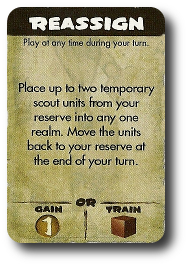
Step 8: Salute War Heroes
The player who currently has captaincy of the honor guard sends 1 unit or 1 honor guard unit to the war hero space on the Warband Roster. These units are out for the duration of the game, but will award points at the end. Check to determine if captaincy has changed for the honor guard or any other Warband Roster space.
Step 9: Raid and Pillage
The two undefeated Enemy cards that remain in the Five Realms now loot, pillage, and destroy. Place 1 Gold on each of the Enemy cards representing their wealth they have stolen from the people of the Five Realms.
Step 10: Draw New Enemy
A new Enemy appears! The player draws a new Enemy card and places it face-up on the battlefield location that was empty before the player took the fight action. Note that the new Enemy card is NOT placed in the same location as the recently removed Enemy card.
If the new Enemy card results in all 3 Enemy cards showing the same platoon type (for example, all infantry), all the Enemy cards are removed from the board and placed at the bottom of the Enemy deck. Three new Enemy cards are then drawn and placed in the same battlefield locations. Gold collected by the Enemy cards prior to be removed remain.
Ending the Round
After the last player takes their turn, the round marker moves down by 1. During rounds 2 and 1 (the final 2 rounds), moving Scouts costs more Gold.
The End of the War
After the last player has completed their turn on the final round, the game comes to an end. Each players’ score is now determined and recorded on the score pad.
- Add up the victory points for every Enemy card collected
- Gain 2 victory points for each unit in the war hero space on the Warband Roster
- Gain 1 victory point for each captain on the Warband Roster
- For every scout and war hero the player has, they can convert 3 Gold into 1 victory point
- The player with the most scouts in each region of the Five Realms is awarded a number of victory points as indicated on the Five Realm map
- The player multiplies the number of scouts they have in a region that matches their Intel cards to determine additional victory points
- The player loses 2 victory points for every unit they have in the Medica space on the Warband Roster
Once the points are calculated, the final score is determined. The player with the most points wins the game.
To learn more about Warband: Against the Darkness, visit the games official web page or visit the Kickstarter campaign.
Prediction
Warband is a Eurogame, but it has some combat thrown in which will make it appealing to those players who hate just pushing cubes. But there is a lot of cube pushing, too, which will appeal to the Eurogamers. Warband would appear to be primed and prepped to meet the needs of all our players. The Child Geeks will like the easy game play, the Parent Geeks should enjoy the game’s overall length and casual game play style, and the Gamer Geeks should enjoy the different ways they can score points, which roughly translates into multiple tactics and strategies.
But I don’t know.
After reading the rules, everything sounds great except the combat. The game hums along and then you enter combat which results in 10 steps of counting, adding, moving stuff around, and dealing out cards. For a game that focuses on fantasy combat, the fighting aspect sounds bit dry. This might hurt Warband a bit in the approval department.
Teaching Warband is exceedingly easy. Just give each player an Action Track, explain what each action does, and then jump to the end of the game so they understand how points are made. What you are doing is giving the players all the information they need to start down their path of possible victory and showing them what the landscape looks like when they cross the finish line. It’s up to the players to make their own choices between the two. I gave each player a copy of the score pad to help them make choices.
You will also want to spend a few minutes focusing on combat. Makes sure you emphasis that Warband is a semi-cooperative game, but the players don’t have much choice regarding when they cooperate. If a player goes into combat as an action, all the other players must go along and support. Then make sure you go over each step of combat to ensure that players understand why they should pause and reflect before they draw their sword.
Note that Warband does require its players to read. Younger Child Geeks can play Warband if someone sits beside them to help read the cards. All the choices in the game are easy to understand and shouldn’t be to difficult for any Child Geek who have played larger board games before.
And so, after teaching Warband to all 3 of my little geeks, I asked them their thoughts on the game so far.
“Super cool. And we can be any of these races? I really like that.” ~ Liam (age 9)
“The map looks nice. I want to explore it!” ~ Nyhus (age 7)
“I want to be the fire guy, Daddy!” ~ Ronan (age 4)
Let’s get Warband on the table and see if it deserves a salute or the back of the hand.
Final Word
Warband received mixed approvals from the Child Geeks. Those Child Geeks who had played Eurogames before enjoyed Warband, while those who preferred the American-style games did not. The biggest sticking point was combat. According to one Child Geek, “This doesn’t feel like a wargame.” Which is to say, this particular Child Geek didn’t feel like they were in a conflict with an evil army. Another Child Geek said, “I like this game because I can do what I want without worrying about stupid dice.” Which is to say, luck plays almost no part in Warband. Which is true. There are random elements, but players are never thrown any curve balls. In the end, the Child Geeks both liked and disliked Warband.
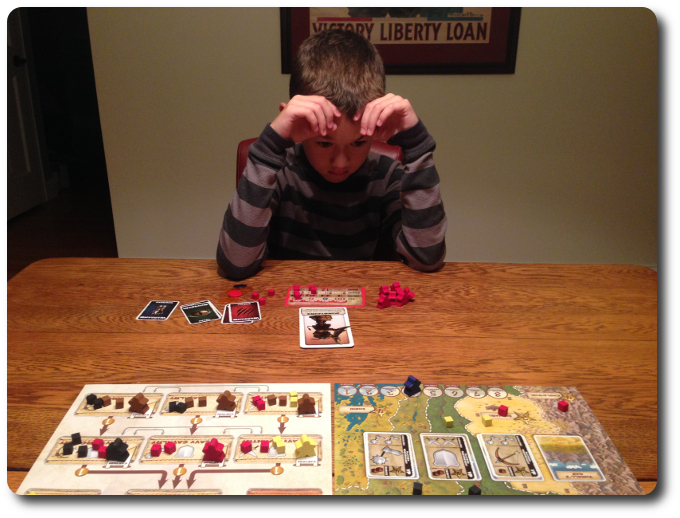
My little geek considers his next move and the battlefield
The Parent Geeks were the same. Those who enjoyed Eurogames found Warband very appealing and those who did not found Warband to be boring. According to one Parent Geek, “I can understand the game’s appeal to some players, but this game just feels like I am pushing little cubes around.” Another Parent Geek said, “I think this game is a bit too abstract. I would expect a fantasy-based game to be full of more visuals and fanfare.” But the Parent Geeks who enjoyed abstract games had a great time with Warband. According to one Parent Geek, “What I really like about this game is how much you have to think about what you are doing on your turn. You can map out your strategy, but you are never forced to follow it. I like games like this a great deal.” And one very enthusiastic Parent Geek said, “Finally! A Euro-style fantasy game that I can teach and play with my kids!” When all the votes were counted, the Parent Geeks gave Warband a mixed level of approval.
The Gamer Geeks recognized Warband immediately for what it was and expected it to deliver on its promise. The Gamer Geeks found that Warband does a lot of neat things, but failed to impress. According to one Gamer Geek, “This game feels like all the other Eurogames I have played, which isn’t bad, but it isn’t very exciting.” Another Gamer Geek said, “I think the game plays pretty well, but I never felt all that excited while playing it.” One aspect of the game that all the Gamer Geeks enjoyed was the multiple ways to score points. This appealed to the all the Gamer Geeks, but also served as a strike against Warband. As one Gamer Geek put it, “Once you figure out the best build for the number of players in the game, there is nothing left to do in the game but watch the clock.” And therein lies what many Gamer Geeks determined as a flaw. One Gamer Geek even called Warband an “abstract fantasy combat game on rails.” Despite the harsh commentary, the Gamer Geek group was split when it came to approving or rejecting the game, giving Warband a mixed approval from the gaming elitists.
Warband tries very hard to be a Eurogame, but falls just short of the mark. Its game play length is about middle of the road, players indirectly interact for the majority of the time, all the components are mostly abstract in nature (but the artwork is superb), luck plays almost no role, strategy is a must, and players are never knocked out of the game. However, Warband also throws in some combat, which feels tacked on due to its abstract nature and the multiple steps a player must take to resolve it. It gives the game a strange vibe that is hard to describe. One player said it was like “taking a bite out of steak and tasting chicken.”
Another aspect of combat that the players didn’t like was that everyone was taken into the fight, even if they weren’t ready for it. It made sense to the players after I reminded them that Warband is a semi-cooperative game, but it still felt to many players that they were being pushed to participate when they weren’t ready. However, they all agreed that the game designer addressed this aspect of the game by providing Redress cards and paying captains. This, at the least, provided some sort of compensation to the players who were forced into the conflict before they were ready.
I personally found combat to be a bit clunky at first, but grew to really enjoy it. Victory points are earned through combat and how a player goes about it is surprisingly important. Like all strategy games, timing and setting up is everything. The same is true for Warband. Combat is the result of pulling a trigger after a player has set up their Warband Roster, Tax, and Scouts. Which is also why combat feels so sluggish. Battling the Darkness is just the logical end to a series of steps and actions. It’s not a grand and epic experience. One Gamer Geek said that combat was like “hitting the equals button on a calculator – just a means to an end.”
Overall, I think Warband is a good time for those who are looking for a fantasy-based Euro gateway game. The game provides a lot of opportunities for new players to explore different tactics and strategies that will prepare them for much more complicated games. The different Race cards give players an incentive to return to the game to play it multiple times and try new approaches, but the overall path to victory will seldom change.
As for my little geeks, several friends, and myself, we enjoyed Warband: Against the Darkness. It played quickly, gave us something to talk about, something to think about, and something to cheer about. It’s also a great way to get non-gamers and inexperienced players to start playing games that will lead to even bigger and better games at the family gaming table. Do give Warband a try if you enjoy Euro-style games with some fantasy flare.
This is a paid for review of the game’s final prototype. Although our time and focus was financially compensated, our words are our own. We’d need at least 10 million dollars before we started saying what other people wanted. Such is the statuesque and legendary integrity of Father Geek which cannot be bought except by those who own their own private islands and small countries.




Pingback: In Review: Father Geek’s Monthly Newsletter (August 2014) - Father Geek
Pingback: In Review: Father Geek’s Monthly Newsletter (September 2014) - Father Geek